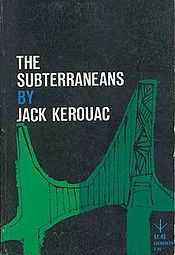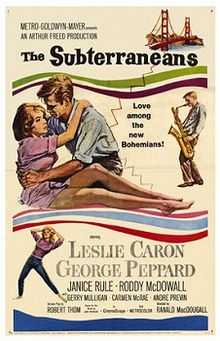The Subterraneans
| The Subterraneans | |
|---|---|
 1st edition cover | |
| Author | Jack Kerouac |
| Cover artist | Roy Kuhlman |
| Country | United States |
| Language | English |
| Genre | Novella |
| Publisher | Grove Press |
Publication date | 1958 |
| Media type | Print (Hardback & Paperback) |
| Pages | Approx. 111 pp |
| ISBN | 0-8021-3186-7 |
| OCLC | 285385 |
| Preceded by | On the Road (1957) |
| Followed by | The Dharma Bums (1958) |
The Subterraneans is a 1958 novella by Beat Generation author Jack Kerouac. It is a semi-fictional account of his short romance with a black woman named Alene Lee (1931-1991) in New York City, 1953.[1] In the novel she is renamed "Mardou Fox," and described as a carefree spirit who frequents the jazz clubs and bars of the budding Beat scene of San Francisco. Other well-known personalities and friends from the author's life also appear thinly disguised in the novel. The character Frank Carmody is based on William Burroughs, and Adam Moorad on Allen Ginsberg. Even Gore Vidal appears as successful novelist Arial Lavalina. Kerouac's alter ego is named Leo Percepied, and his long-time friend Neal Cassady is mentioned only in passing as Leroy.
Character Key
Kerouac often based his fictional characters on friends and family.[2][3]
"Because of the objections of my early publishers I was not allowed to use the same personae names in each work." [4]
| Real-life person | Character name |
|---|---|
| Jack Kerouac | Leo Percepied |
| Anton Rosenberg | Julian Alexander |
| Iris Brodie | Roxanne |
| William S. Burroughs | Frank Carmody |
| Joan Vollmer | Jane |
| Lucien Carr | Sam Vedder |
| Neal Cassady | Leroy |
| Gregory Corso | Yuri Gligoric |
| Allen Eager | Roger Beloit |
| William Gaddis | Harold Sand |
| Allen Ginsberg | Adam Moorad |
| Luanne Henderson | Annie |
| John Clellon Holmes | Balliol MacJones |
| Bill Keck | Fritz Nicholas |
| Alene Lee | Mardou Fox |
| Jerry Newman | Larry O'Hara |
| Gore Vidal | Arial Lavalina |
This Photo by Allen Ginsberg shows William S. Burroughs and Alene Lee, two of the novella's central characters, talking on the roof of Ginsberg's apartment building in New York City. Taken in 1953, this photo likely depicts the two as they appeared during the time described by Kerouac in The Subterraneans.
Criticism and literary significance
The novel, written as a first-person memoir, has been criticized for its portrayal of American minority groups, especially African Americans, in a superficial light, often portraying them in a humble and primitive manner without showing insight into their culture or social position at the time. The position of jazz and jazz culture is central to the novel, tying together the themes of Kerouac's writing here as elsewhere, and expressed in the "spontaneous prose" style in which he composed most of his works. The following quotation from Chapter 1 illustrates the spontaneous prose style of The Subterraneans:
Mardou:
| “ | Making a new start, starting from fresh in the rain, 'Why should anyone want to hurt my little heart, my feet, my little hands, my skin that I'm wrapt in because God wants me warm and Inside, my toes--why did God make all this so decayable and dieable and harmable and wants to make me realize and scream--why the wild ground and bodies bare and breaks--I quaked when the giver creamed, when my father screamed, my mother dreamed---I started small and ballooned up and now I'm big and a naked child again and only to cry and fear. - Ah - Protect yourself, angel of no harm, you who've never and could never harm and crack another innocent in its shell and thin veiled pain - wrap a robe around you, honeylamb - protect yourself from harm and wait, till Daddy comes again, and Mama throws you warm inside her valley of the moon, loom at the loom of patient time, be happy in the mornings. | ” |
Film version
| The Subterraneans | |
|---|---|
 | |
| Directed by | Ranald MacDougall |
| Produced by | Arthur Freed |
| Written by | Robert Thom |
| Based on | novel by Jack Kerouac |
| Starring |
George Peppard Leslie Caron Roddy McDowall Janice Rule |
| Distributed by | Metro-Goldwyn-Mayer |
| Release dates | 1960 |
| Country | United States |
| Language | English |
| Budget | $1,407,000[5] |
| Box office | $765,000[5] |
A 1960 film adaptation changed the African American character Mardou Fox, Kerouac's love interest, to a young French girl (played by Leslie Caron) to better fit both contemporary social and Hollywood palates. While it was derided and vehemently criticized by Allen Ginsberg among others, for its two-dimensional characters, it illustrates the way the film industry attempted to exploit the emerging popularity of this culture as it grew in San Francisco and Greenwich Village, New York.
A Greenwich Village beatnik bar setting had been used in Richard Quine's film Bell, Book and Candle (1958), but Ranald MacDougall's adaptation of Kerouac's novel, scripted by Robert Thom, was less successful.
The Subterraneans was one of the final MGM films produced by Arthur Freed, and features a score by André Previn and brief appearances by jazz singer Carmen McRae singing "Coffee Time," and saxophonists Gerry Mulligan, as a street priest, and Art Pepper. Comedian Arte Johnson plays the Gore Vidal character, here named Arial Lavalerra.
Box Office
According to MGM records the film earned only $340,000 in the US and Canada and $425,000 elsewhere resulting in a loss of $1,311,000.[5]
External links
- The Subterraneans at IMDB
- The Subterraneans at TCMDB
References
- ↑ Wills, David (ed.), Beatdom Vol 6, City of Recovery Press, 2010
- ↑ Sandison, Daivd. Jeck Kerouac: An Illustrated Biography. Chicago: Chicago Review Press. 1999
- ↑ Who’s Who: A Guide to Kerouac’s Characters
- ↑ Kerouac, Jack. Visions of Cody. London and New York: Penguin Books Ltd. 1993.
- ↑ 5.0 5.1 5.2 The Eddie Mannix Ledger, Los Angeles: Margaret Herrick Library, Center for Motion Picture Study.
- 1958. The Subterraneans, ISBN 0-8021-3186-7
Further reading
- O'Sullivan, S., 'Alene Lee: Subterranean Muse', in Wills, D. (ed.) Beatdom Vol. 4 (Mauling Press: Dundee, 2009) p. 20
| |||||||||||
| |||||